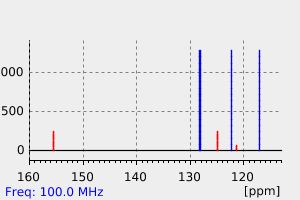9,9'-二亚呫吨 | 517-45-3
中文名称
9,9'-二亚呫吨
中文别名
9,9'-二亚吨;9,9"-二亚呫吨
英文名称
dixanthylene
英文别名
9,9'-bixanthenylidene;Dixanthylen;Bixanthylen;9,9'-bi(9H-xanthen-9-ylidene);[9,9']Bixanthenyliden;bixanthene;9-(9H-Xanthen-9-ylidene)-9H-xanthene;9-xanthen-9-ylidenexanthene
CAS
517-45-3
化学式
C26H16O2
mdl
——
分子量
360.412
InChiKey
SXXWAWNPJCEOGD-UHFFFAOYSA-N
BEILSTEIN
——
EINECS
——
-
物化性质
-
计算性质
-
ADMET
-
安全信息
-
SDS
-
制备方法与用途
-
上下游信息
-
文献信息
-
表征谱图
-
同类化合物
-
相关功能分类
-
相关结构分类
物化性质
-
熔点:318-320°C
-
沸点:494.2±45.0 °C(Predicted)
-
密度:1.300±0.06 g/cm3(Predicted)
-
稳定性/保质期:
按规格使用和贮存,不会发生分解,避免与氧化物接触。
计算性质
-
辛醇/水分配系数(LogP):5.9
-
重原子数:28
-
可旋转键数:0
-
环数:6.0
-
sp3杂化的碳原子比例:0.0
-
拓扑面积:18.5
-
氢给体数:0
-
氢受体数:2
安全信息
-
危险品标志:Xi
-
危险类别码:R36/37/38
-
海关编码:2934999090
-
安全说明:S26,S36/37
SDS
制备方法与用途
合成制备方法
暂无相关信息。
用途暂无相关信息。
上下游信息
-
上游原料
中文名称 英文名称 CAS号 化学式 分子量 氧杂蒽 xanthene 92-83-1 C13H10O 182.222 -
下游产品
中文名称 英文名称 CAS号 化学式 分子量 9-(二苯基亚甲基)-9H-呫吨 9-(diphenylmethylene)xanthene 27265-96-9 C26H18O 346.428
反应信息
-
作为反应物:参考文献:名称:联蒽酮及相关物质的光化学反应摘要:研究了多种乙烯化合物的光解反应。光敏氧化导致形成它们相应的酮。另一方面,这些底物与元素硫的光反应产生了相应的硫代酮。此外,还研究了一些乙烯环硫化物的光行为。可以得出结论,紫外线辐射为此类化合物提供了快速有效的失活途径。DOI:10.1016/s0040-4020(01)87036-8
-
作为产物:参考文献:名称:铑(II)/铑(III)氧化还原对与烷基叠氮化物的C-H键胺化:具有四齿[14]-大环配体的铑(III)-氮烯类中间体摘要:研究了铑( II )二聚体络合物[Rh II (TMAA)] 2 (TMAA = 四甲基四氮杂[14]轮烯)在与有机叠氮化物的C-H胺化反应中的催化活性。具有吸电子基团的有机叠氮化物 (N 3 –R),例如磺酰基(三磺基叠氮化物;R = S(O) 2 iPr3 C 6 H 2 (Trs))和简单烷基 (R = (CH 2 ) 4 Ph、(CH 2 ) 2 OCH 2 Ph、CH 2 Ph 或 C 6 H 4 NO 2 ) 用于分子内和分子间 C-H 键胺化反应。使用 ESI 质谱和 EPR 光谱技术对 [Rh II (TMAA)] 2和 N 3 –R 生成的反应中间体进行光谱分析表明,铑( III )–氮烯类物质是 C–H 键中的活性氧化剂胺化反应。 DFT 计算表明该物质可以具有自由基局部氮原子。 DFT计算研究还表明,胺化反应涉及2 N˙R的NR部分从有机底物R′-H中夺取氢原子,以及DOI:10.1039/d3dt03429a
文献信息
-
Tetradentate platinum and palladium complex emitters containing phenyl-pyrazole and its analogues申请人:ARIZONA BOARD OF REGENTS ON BEHALF OF ARIZONA STATE UNIVERSITY公开号:US10020455B2公开(公告)日:2018-07-10A phosphorescent emitter or delayed fluorescent and phosphorescent emitters represented by Formula 1 or Formula II, where M is platinum or palladium.
-
Tetradentate Platinum And Palladium Complex Emitters Containing Phenyl-Pyrazole And Its Analogues
-
Chemical and physical properties of 9-xanthylidene: a ground-state singlet aromatic carbene作者:Stephen C. Lapin、Gary B. SchusterDOI:10.1021/ja00300a028日期:1985.7Preparation du carbena-9xanthene par irradiation du diazo-9xanthene. Detection par spectroscopie d'absorption laser. Le carbene reagit rapidement avec les alcools pour former des ethers et avec les styrenes pour donner des cyclopropanes stereospecifiquement制备 du carbena-9xanthene par 辐照 du diazo-9xanthene。检测标准光谱吸收激光。Le carbene reagit Rapidement avec les alcools Pour 前 des ethers et avec les 苯乙烯
-
Stereoselective synthesis of olefins by a reductive coupling reaction作者:Guoxiong Hua、Yang Li、Alexandra M. Z. Slawin、J. Derek WoollinsDOI:10.1039/b702818k日期:——Ketones and aldehydes are converted to symmetrical and (E)-olefins (1-15) by reaction with 2,4-bis(phenyl)-1,3-diselenadiphosphetane-2,4-diselenide (PhPSe(2))(2), Woollins' reagent, in refluxing toluene; use of diketones was demonstrated by the reaction of PhC(O)CH(2)C(O)Ph which gives 1,2,4,5-tetraphenylbenzene (16) in 83% yield.酮和醛通过与2,4-双(苯基)-1,3-二硒二氮杂环戊烷-2,4-二硒化物(PhPSe(2))(2)反应而转化为对称和(E)-烯烃(1-15) ,伍林斯的试剂,在回流的甲苯中;PhC(O)CH(2)C(O)Ph的反应证明了二酮的使用,该化合物以1,83%的产率得到1,2,4,5-四苯基苯(16)。
-
Bimolecular Formation of Radicals by Hydrogen Transfer, 12. – Transfer hydrogenation ofp-Substituted α-Methylstyrenes and of 9-Methylenefluorene as a Criterion of Mechanism作者:Heike Friebolin、Rolf Roers、Jochen Ebenhoch、Matthias Gerst、Christoph RüchardtDOI:10.1002/jlac.199719970216日期:1997.2the solvent effect is small. A hydrogen atom transfer mechanism (retrodisproportionation) is, therefore, preferred to a hydride transfer mechanism. This is supported by the very similar reactivity of the hydrogen transfer reaction of DHA and XAN with 9-methylenefluorene. The product yields in all reactions investigated in this project were >90%.
表征谱图
-
氢谱1HNMR
-
质谱MS
-
碳谱13CNMR
-
红外IR
-
拉曼Raman
-
峰位数据
-
峰位匹配
-
表征信息
同类化合物
(S)-8-氟苯并二氢吡喃-4-胺
(2S)-6-氟-3,4-二氢-4-氧代-2H-1-苯并吡喃-2-甲酸
(2R)-6-氟-3,4-二氢-4-氧代-2H-1-苯并吡喃-2-甲酸
龙胆根素
龙胆SHAN酮
齿阿米素
黑色素-1
黄天精
麥角黃酮酸
鲍迪木醌
高邻苯二甲酸酐
高芒果苷
高氯酸罗丹明640
马佐卡林
香豆素-340
香豆素 339
食用色素红色105号
颜料红90:1铝色淀[CI45380:3]
颜料红172铝色淀[CI45430:1]
雏菊叶龙胆酮
降阿赛里奥; 1,3,6,7-四羟基氧杂蒽酮
阿米醇
阿米凯林
阿米凯林
阿扎那托
阿巴哌酮
阿尼地坦
阿尼地坦
阿匹氯铵
锌离子荧光探针-4
锆(2+)二[2-(2,4,5,7-四溴-3,6-二羟基氧杂蒽-9-基)-3,4,5,6-四氯苯甲酸酯]
铁力木呫吨酮-B
铁力木吨酮A
钠6'-羟基-5-[2-[4-(2-甲基-3-氧代-7H-咪唑并[1,2-d]吡嗪-6-基)苯氧基]乙基硫代氨基甲酰氨基]-3-氧代螺[2-苯并呋喃-1,9'-氧杂蒽]-3'-醇
钠4-{[6'-(二乙基氨基)-3'-羟基-3-氧代-3H-螺[2-苯并呋喃-1,9'-氧杂蒽]-2'-基]偶氮}-3-羟基-1-萘磺酸酯
钠2-(2,7-二氯-9H-氧杂蒽-9-基)苯甲酸酯
钙黄绿素乙酰甲酯
钙荧光探针Fluo-8,AM
钙荧光探针Fluo-4,AM
钙离子荧光探针
钙柑子
采木(HAEMATOXYLONCAMPECHIANUM)木质提取物
酸性媒介桃红3BM
邻苯三酚红
远志山酮III
转移核糖核酸(面包酵母)
赤藓红B异硫氰酸酯异构体II
赤藓红
诺大麻
西伯尔链接剂







